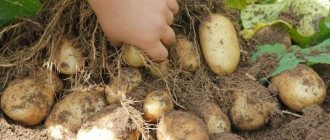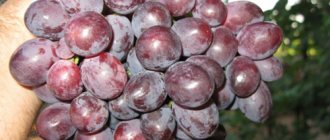Every fan of growing tomatoes in their garden asks the question: which variety to choose? The Giant Raspberry tomato is the best choice because the variety has a number of distinctive features, the main one being the gigantic size of the fruit.
Getting a good harvest, not experiencing any special difficulties in the growing process, getting real pleasure from cultivating a particular crop - all this is possible if the Raspberry Giant grows in the garden. This variety of tomatoes has long gained popularity among experienced gardeners because it produces an excellent harvest without making serious demands on growing conditions and care.
It is necessary to grow this variety of tomato in a greenhouse, but residents of the southern regions of the country can afford to plant the Giant in open ground.
general information
Giant is the best representative of all salad varieties. In terms of ripening time, it is classified as mid-season, because from the moment the seeds are sowed for seedlings until the appearance of the first ripened fruits, about 105 - 110 days pass.
The plant is standard, determinate. Growth is limited: the tallest tomato bush will be about 1 m 80 cm. The average height of tomato bushes of this variety is from 130 to 150 centimeters. The smallest specimens can be about 1 meter in height. This is determined by the conditions of agricultural technology and the climatic situation.
From the name it is clear that this variety of tomatoes is famous for the large size of the fruits and the bush itself. To cultivate Giant, you need a lot of space.
The greenhouse should be spacious and comfortable. In adulthood, the plant is very tall, so when designing a greenhouse, do not forget about such a key parameter as height.
The ripening period for Giant Raspberry is average. It is customary to start sowing seeds approximately 90 days before it is time to transplant the seedlings into open ground - approximately in mid-March. From the moment the first shoots appear until the first fruits ripen, at least 105 days pass, but the exact dates are dictated by factors such as weather conditions, growing principles, plant condition and even the experience of the gardener.
The southern regions of the country, such as the Astrakhan, Voronezh, Belgorod regions, and Krasnodar Territory, can allow gardeners to grow Giant in open ground. A large number of daylight hours and warm summers are excellent conditions for growing a representative of this variety.
If cultivation is to be carried out in areas where cool weather prevails or sudden changes in day and night temperatures are likely, then it is better to transfer the growing process to a greenhouse.
Tomatoes of the Giant Raspberry variety are demanding on the composition of the soil, so you should not forget about feeding the plants. This must be done throughout the growing season. During the growth period, fulfilling this requirement is especially important, since the ovary is formed
. To maintain this process, Giant tomatoes need to be given phosphorus and potassium as part of mineral fertilizers.
The size of the Giant fruits is quite large. The former often have a mass of around 500 grams. Everyone who has planted this variety notes that the subsequent harvest becomes smaller, the weight of the fruit is 0.3 - 0.4 kg. When ripe, tomatoes have a bright crimson or pink color. Inside a round tomato there are five or six chambers, each containing a small number of seeds.
See also
Characteristics and description of the tomato variety Fighter (Buyan), its yieldRead
Planting and care
It is necessary to plant seedlings in the ground taking into account that the adult plants are not crowded . The distance between seedlings should be at least half a meter, and more than four plants cannot grow on one square meter. Since the tomato bush of this variety is tall, it definitely needs a garter; this will also serve as additional protection if you plan to plant tomatoes in open ground.
While the ovary is forming, this variety of tomatoes simply needs fertilizer containing potassium and phosphorus; during the growth process, the amount of feeding can be reduced.
In addition, the plant needs regular watering.
Lifehack . If it is not possible to water the soil frequently, but you want to avoid it drying out quickly, you can use mulching. A method learned from nature itself, when the soil is covered with a special mulch, preferably organic. In this case, not only will the soil not dry out and become crusty, but it will not have to be loosened often. And organic mulch, such as freshly cut grass, compost or straw, will also serve as fertilizer.
Stepsoning
In order not to turn your tomato beds into a jungle and to get a good harvest, you need to do pinching . Beginner summer residents have questions: what are “stepchildren”, why remove them and how to do it correctly? Stepchildren are branches from the main stem, competing shoots. They appear from the leaf axil at the beginning of flowering. It is best to leave one of the most powerful ones, and remove all the others growing on it.
This can be done either with your hands, tearing it to the side and not down, so as not to damage the skin of the plant, or using garden shears. After each pruned plant, the scissors are washed in a solution of potassium permanganate so as not to spread the infection to the entire bush, if any.
It is best to plant plants once a week in the early morning on a sunny day , then the “wound” will have time to heal within a day. If the stepsons have not been picked for a long time and then decided to carry out the procedure in one day, then this will be a lot of stress for the bush.
PICKING TOMATO WHEN TO START HOW AND WHY IS IT NEEDED?
Possible difficulties and features of cultivation
In order to avoid difficulties with growing a giant, you need to remove weeds in a timely manner and feed the seedlings with mineral fertilizers . The giant is sensitive to changes in air temperature and the forgetfulness of gardeners; the plant needs to be watered regularly.
A large number of sunny days is also extremely important for the variety ; this affects the taste and sugar content of the future harvest. Despite the fact that this variety is not predisposed to diseases, it is still worth carrying out preventive measures: both against diseases and against pests.
Description of fruits
The main characteristics of the fruits of the Giant crimson are as follows:
- Color - from bright pink to dark crimson.
- The shape of the fruit is round.
- Excellent taste: tomatoes are juicy, sweet and have a typical tomato note.
- The weight of fruits from the first harvest reaches 0.5 kg.
- The fruits have an average weight of 0.3 - 0.4 kg.
- A small number of seeds in the chambers.
- Dry matter content is around 5%.
- Long shelf life.
- The crop tolerates transportation well, even over long distances.
Thanks to the combination of all the characteristics described above, gardeners have an excellent opportunity to grow large volumes of these tomatoes due to their good keeping quality.
Reviews about the variety from those who planted
Let's see how gardeners respond to growing tomatoes of this variety.
Alina Kornilova, 57 years old: “I have tried many varieties of tomatoes and have been growing Giant for several years now. My whole family loves the taste of these tomatoes. In the first year there were difficulties; I didn’t calculate the size of the bushes; they were uncomfortable in the greenhouse. But the very next season I took into account all the mistakes and got a very good harvest.”
Dmitry Semenov, 42 years old: “I live in the Krasnodar region, I grew Giant Raspberry in open ground. What pleased me most was that there were no problems with pests, the main thing is not to forget to tie up the bushes - when there is a lot of sun and warmth, the bushes grow huge. They ate the first harvest like this, and the smaller ones that came later were salted.”
Irina Vyseltseva, 67 years old: “A friend recommended this variety to me and treated me to her tomatoes, I really liked it, and decided to grow it too. There weren’t any particular problems; I’m an experienced gardener. I can only advise using mineral fertilizers first.”
300 varieties of tomatoes on one site at once
Due to its excellent preservation over a long period and good transportability over long distances, the tomato variety “Giant Raspberry” is especially popular in farms.
The tomato variety “Giant Raspberry” guarantees a large harvest of large, tasty fruits. Despite the presence of certain difficulties in care, it is enough to follow simple rules of care.
Peculiarities
The most striking feature of tomatoes of this variety is their outstanding taste characteristics. The fruits of the Giant are juicy, sweet, with a characteristic tomato taste. The pulp is very sugary and dense.
Storing this variety is not difficult. A garage, closet, or room are perfect for this purpose. Transportation over long distances is possible: the giant will not crack, will retain its presentation and excellent taste. Thanks to these parameters, it becomes possible to grow this tomato in large quantities.
In terms of use, tomatoes are universal. Due to their excellent taste, they can be planted for salads and fresh use. As part of winter salads and preparations, Ispolin will delight you with its juicy pulp and excellent tomato taste.
If this tomato becomes the basis for sauces, tomato paste or ketchup, then the product is guaranteed a beautiful and bright color, something in common with raspberries, and a pronounced taste. If the season ends and the size of the fruit decreases, you can focus on canning: the small late fruits of the Giant will become an excellent canned dish.
Tomato "Giant" - large-fruited variety
If you want to grow really large tomatoes on your plot, then be sure to pay attention to the “Giant” variety. This mid-season species is suitable for planting both in a greenhouse (in the middle zone) and in open ground (in the southern regions).
Main characteristics and features of the variety
On average, just over three months pass from seed germination to harvest ripening.
On tall, vigorous bushes, the height of which can reach one and a half meters, fruits appear weighing an average of 400-500 grams. Round tomatoes of a rich raspberry or pink hue inside have six chambers with a small number of seeds. Tomatoes "Giant" have a harmonious sweetish taste. The dense pulp is quite juicy and meaty. Due to these properties, they are most often used as fresh food, added to vegetable salads.
The strong skin does not crack, so they can be safely transported and stored. Large fruits can be used to make tomato juice or sauce. And smaller tomatoes are ideal for winter preparations.
Advantages and disadvantages of the "Giant" variety
Tomatoes of this variety have a number of advantages that make them very popular among gardeners:
- High yield rates (10 kg per bush);
- Harmonious, pronounced tomato taste;
- The fruits retain their presentation for a long time and can easily be transported;
- "Giant" is resistant to many diseases.
However, it should be taken into account that these tomatoes are very demanding in terms of light and heat conditions. It is important for plants to maintain proper and regular watering. Due to the large fruits and tall stems, the bushes must be tied up.
Growing and care
When planting tomato seedlings of the “Giant” variety in open ground or a greenhouse, you need to remember that these plants need space. Therefore, it is better if per 1 sq. m. there will be 3 (maximum 4) bushes. The use of supports is also mandatory.
At the growth stage and during the formation of ovaries, it is necessary to apply fertilizers that contain potassium and phosphorus. It is important to ensure regular watering, weeding and pinching.
To prevent tomatoes of the “Giant” variety from being affected by diseases such as blossom end rot and brown spot, preventive treatment of the bushes is carried out with special preparations. It is equally important to monitor the acidity level, do not forget about loosening the soil and ensuring good ventilation of the plantings. Professional products or formulations prepared according to folk recipes will help against pests such as aphids, mole crickets, and slugs.
Advantages and disadvantages
The characteristics and description of the Giant tomato variety are surprising. The popularity of the variety among gardeners can be quite understandable due to its many advantages:
- high yield: correct care will allow you to get up to 10 kilograms of fruit;
- good keeping quality: when harvesting a large harvest, the gardener will not have to quickly get rid of tomatoes that are about to spoil;
- resistance to characteristic diseases.
See also
Description of Zebra tomato of different colors and characteristics of the varietyRead
Despite the huge number of advantages, Giant Raspberry also has some disadvantages:
- demands on the amount of sunlight and heat;
- sensitive response to failures in the irrigation system;
- the need for garter and plant support.
If you care for these tomatoes competently and in a timely manner, a good harvest will not be long in coming. Impressive size, excellent taste and pleasant aroma are the advantages for which gardeners are so fond of the Giant tomato.
Tomato “Giant”: characteristics and description of the variety
Almost every gardener grows tomatoes When choosing a variety, home garden owners are faced with a choice: they want tomatoes to please with their taste, look attractive, do not require special care and have high yields. “Giant” is exactly such a variety, the distinctive feature of which is the large size of the fruits. It will suit you if you have a spacious greenhouse designed for growing tomatoes, but in the southern regions these tomatoes can also be planted in open ground.
Description of the variety "Giant"
As the name suggests, this tomato variety is distinguished by its significant size, and this applies not only to the fruits, but also to the bush itself. That is why a large, spacious greenhouse is needed to grow it. The plant reaches a height of 180 cm in adulthood, the smallest bushes are 100 cm, which depends on the growing conditions.
According to the ripening period, “Giant” tomatoes can be classified as mid-season varieties. Seeds for seedlings should be sown approximately three months before transplanting the plants into the greenhouse, that is, at the end of March - beginning of April. After the seedlings germinate and until the first fruits appear, at least 105 days pass. The exact period depends on growing conditions.
In the southern regions - Astrakhan, Belgorod, Voronezh regions, in the Krasnodar Territory, "Giant" tomatoes can also be grown in open ground. The variety is demanding of heat and light, so in cooler climates it is better to plant it in greenhouses.
Tomatoes of the "Giant" variety definitely require feeding during the growing season. This is especially true at the growth stage, as well as during the formation of ovaries. Fertilizers must contain phosphorus and potassium.
Growing Giant tomato
Cultivation of tomatoes of this variety in the ground is possible only in regions where there are a large number of sunny days. This condition is determined by the heat-loving nature of the plant and its requirements for light. Ideal places to grow Giant are the following areas:
- Belgorodskaya.
- Astrakhan.
- Voronezhskaya.
- Saratovskaya.
- Krasnodar region.
- Caucasus.
If you grow a tomato a little further north, then the variety can only grow in a greenhouse. Regulated heat supply and the possibility of increasing its concentration are excellent opportunities that are so necessary when growing this variety of tomatoes.
Sowing seeds for seedlings begins 65 - 70 days before the date of planting in open ground. When two leaves appear, the sprouts are picked. Planting in black soil is carried out in such a way that tall plants are not crowded.
A distance of at least 0.5 m should be maintained between seedlings, and the number of plants per 1 sq. m should not exceed four.
After planting in a greenhouse or open bed, caring for the Giants should be continued. It should consist of timely watering, removing shoots, eliminating weeds, and feeding plants with mineral fertilizer. To prevent the substrate from drying out, you can resort to mulching.
Giant raspberry is a variety that is resistant to pests and diseases, but preventive measures never hurt. It is necessary to maintain the level of soil and air humidity in the greenhouse, monitor the condition of the plants, and conduct a systematic preventive visual inspection of the plants for the appearance of unwanted “neighbors.” A black coating on the leaves should make you wary.
Resistance to diseases and pests
The Raspberry giant tomato has good resistance to many diseases characteristic of plants of the nightshade family.
Diseases
There is, however, a possibility of Giant's disease
- blossom end rot: to prevent it, you need to monitor the level of nitrogen in the soil; To avoid its increase, it is useful to add calcium to the soil. You should also prevent the soil from drying out and monitor the humidity level. Affected plants can be sprayed with a solution of calcium nitrate (10 liters of water + 100 g of calcium nitrate). This solution is also an excellent preventative against slugs and ticks;
- brown spot: to prevent it from affecting plants, you should avoid waterlogging and monitor the temperature (which is especially important for indoor soil); Regular ventilation of the room is necessary. This fungal disease most often affects tomatoes growing in greenhouses. Diseased plants should be sprayed with fungicides that contain copper. It should be sprayed for preventive purposes in early spring, before flowering begins, and again after a couple of weeks. To minimize the risk of disease, you should follow the rules of agricultural technology and monitor the level of humidity, light, and temperature in closed ground.
To prevent the possibility of tomato diseases, it is better to take preventive measures, plant the plants correctly, observing the distance prescribed in agricultural technology, do not thicken the plantings, and do not plant peppers, potatoes and other nightshades next to tomatoes, which have common pathogens.
Pests
In addition to diseases, tomato is threatened by various insect pests:
- thrips: you can get rid of it by spraying the bushes with Fitoverm (10 ml + 1 liter of water) once every three weeks. Spraying with herbal infusions (from dandelion, garlic, tomato tops or celandine) helps a lot; mustard solution (1 liter of water + 1 tsp mustard powder), etc.
- melon aphid, etc.: the ladybug loves to destroy it, so it’s worth breeding these bugs in your area; Spraying, for example, with Iskra, a universal remedy against pests of garden crops, helps; Tobacco infusion also helps (1 liter of boiling water + 0.5 kg of tobacco, boil everything for 30 minutes, strain and dilute in 10 liters of water), process the tomatoes in a greenhouse every five days. Planting garlic and onions next to tomatoes works well to repel aphids;
- slugs: they really don’t like ground hot pepper and mustard, which must be diluted in water and watered with the solution on the soil near the bushes (10 liters of water + 1 tablespoon of pepper);
- mole cricket: in addition to watering the soil with pepper or mustard solution, it is good to plant tomatoes with Chinese cloves, for example, and Medvetox and other drugs against this pest also help.
It is always easier and simpler to prevent pests from appearing or multiplying than to try to get rid of them later. Regular preventive inspections of plantings are useful; in closed ground - maintaining the level of humidity and light, as well as temperature conditions, regular ventilation and keeping the room clean, etc.
Clue! In order for any infusions, decoctions, or solutions to stay on plants longer, it is good to add a soap solution to the liquid. It is better to prepare soap concentrate in advance, and then add it to any infusion or decoction as needed.
Method of use
There are several options for consuming the fruits of the Giant raspberry tomato:
- fresh as the main ingredient in salads;
- for canning - you can use late harvest;
- for preparing tomato juice;
- as an ingredient in sauces and ketchup.
Eating tomatoes of this variety in any form will bring great pleasure, because the tomatoes are soft, juicy, and tasty. Growing such fruits does not require much effort, and the result pleases with its gigantic size, high yield and quality, receiving only positive feedback from gardeners.
History of the variety
There is little data on the development of the Giant Raspberry variety, although this tomato has been known to vegetable growers for a couple of decades. But much more is known about another variety of the variety - the Giant pink tomato. But their quality characteristics are still different.
HIT!
• The large-fruited variety HEAVYLIFE of Siberia
The Giant crimson variety was bred by breeders from the NK LTD Research and Production Company, located in Moscow. This tomato was included in the State Register of Russia in 2000 and zoned for cultivation in most regions of the country. This tomato can be planted in garden beds and in protected ground. But the annotation for the variety indicates that it is preferable to grow the Giant raspberry tomato in the south of Russia.
Tomato Giant photo
Bush care
Despite the following planting recommendations, the plant also needs proper care:
- Watering is carried out as needed, the surface layer should not dry out. For irrigation use warm, settled water. Water the row spacing, preventing moisture from getting on the tomato seedlings;
- To prevent the soil from drying out, and also to reduce the number of weedings, the bed is mulched with straw and mown grass;
- The bush must be formed into one or two stems, in most cases two;
- As the plant grows, tie it up. The support will also serve as additional protection from winds when growing in unprotected soil;
- During active growth and formation of ovaries, plantings are fed with fertilizers enriched with potassium and phosphorus. Subsequently, the amount of fertilizer is reduced;
- When grown in greenhouse conditions, it is necessary to control the level of humidity, light and temperature. Also, do not forget about regular ventilation of the greenhouse structure.
Seedlings are planted in open ground and in a greenhouse according to a pattern of 50 cm in a row, 70 cm between rows. The seedlings are immediately secured to a trellis or stakes. Tomato care is standard and consists of maintaining optimal soil moisture, weeding and pinching.
The vines are formed into two stems, removing all shoots. When they reach a height of 180-200 cm, the tops are pinched.
Mid-season / Tall
User rating: 4/5
Early maturing / Tall
User rating: 4/5
Mid-season / Tall
Reviews
Giant raspberry - has not failed for 5 years now, large-fruited, medium-life, tasty both for salad and for processing
Marincha, Dacha in Balabanovo, Kaluga region.
https://dacha.wcb.ru/index.php?showtopic=61296&st=0
Red giant? The taste is average for me, good for pasta, although I wanted raspberry.
Katy, Moscow
https://forum.tvoysad.ru/viewtopic.php?t=10749&start=120
“Giant” is a salad variety, excellent taste, very large fruits.
Apple
https://nashausadba.com.ua/forum/threads/sorta-tomatov.180/
For myself, I plant Pink Flamingo from salad bowls for food and for Giant and Bear's Paw tomatoes.
Kristina Volkova, Lugansk region
https://forum.vinograd.info/showthread.php?p=1256133
Our giant is not gaining all its mass (apparently there is still not enough sun).
Ksyushka, Moscow
https://dachniiotvet.galaktikalife.ru/viewtopic.php?t=78
Tomato Giant is one of the representatives of the so-called giant tomatoes. It is quite old, and now worthy competitors have appeared as salad varieties, with improved taste and other higher characteristics. Nevertheless, adherents of the variety still grow it in their summer cottages.











